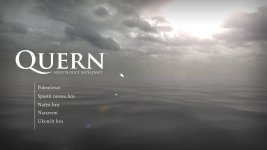
There are other sorts of puzzles (starting engines, finding passwords, using the mine cart) - but they're very much the Lord High Everything Else. Obduction was built primarily around one puzzle mechanism: the seed machines. This is a useful trick for keeping the player out of stuck-unwinnable states.) Once door X is open, it stays open for the rest of the game.

Once the power has been turned on, it stays on. That's how real life works! But when designing a game, you often want to simplify.

(You might say that every control should be flippable back and forth. It's particularly annoying when the effect of the switch is not directly visible then then you have no way to experiment to figure it out. The control might retract to show that it's locked, or you might see a pin drop into place. Obduction is good about showing the difference between a two-way switch (which can be flipped back and forth) and a one-way switch (which locks after you flip it). Quern is generally in tune with Cyan's house style, but it misses a few of the details. It also avoids puzzles that make you think "if I only had a hammer." (Or garden shears, or a couple of sticks, or.) In contrast, Obduction keeps the really tempting tools out of reach. Even more annoying, there's a loose ladder in the very first room, but you can't take it or use it to climb anywhere. So many hammers! There are things in the game that I want to smash! Sorry, no hammer for you.
Quern steam full#
You will frequently find a workbench full of tools, and it's not at all clear which are the important tools and which are just scenery. Quern has lots of visual detail, but it's not so good on focus. Now I can talk about the differences - which are smaller, but more interesting to discuss. And I finished both in roughly 15 hours of play time. Both are lonely worlds they avoid human interaction (and thus the high costs of character modeling and animation). They both take advantage of the 3D world engine, both visually and in their puzzle design. Both have really great, creatively constructed puzzles. Quern and Obduction are both top-notch adventure games. (Note that that " Characterizing IF" post is harsh on CYOA games. They are graphical IF in the sense that I used to talk about: you must engage with them immersively, placing yourself in the world, imagining those objects around you (and in your hands), considering what makes sense to do in that physical reality. They're both aiming at the same target: a first-person adventure in which the puzzles span every aspect of the environment. Just as it was impossible to talk about Obduction without comparing it to Myst, I cannot talk about Quern without comparing it to Obduction. (Note: I was a Kickstarter backer on Quern. Spoiler: those are the two good ones, so far. Give the point back for making progress on a KS payout way less than a million dollars.)Īnd I have played Obduction, and now I have played Quern: Undying Thoughts.
Quern steam plus#
(To be sure, Xing's Kickstarter predated Obduction's - plus one point for foresight, minus one point for taking longer. Of those, I have now played Haven Moon (my notes in this post) and Neptune Flux (didn't have much to say). Sure enough, a couple of years later, I saw several Myst-inspired projects on Kickstarter and Steam Greenlight. Then Cyan got a million dollars out of nostalgic Myst fans. With Unit圓D well-established and the Unreal 4 engine coming up, small teams were in a good position to produce really stellar visual environments.


When the Obduction kickstarter fired up in 2013, it seemed like a good moment for adventure games in general.


 0 kommentar(er)
0 kommentar(er)
